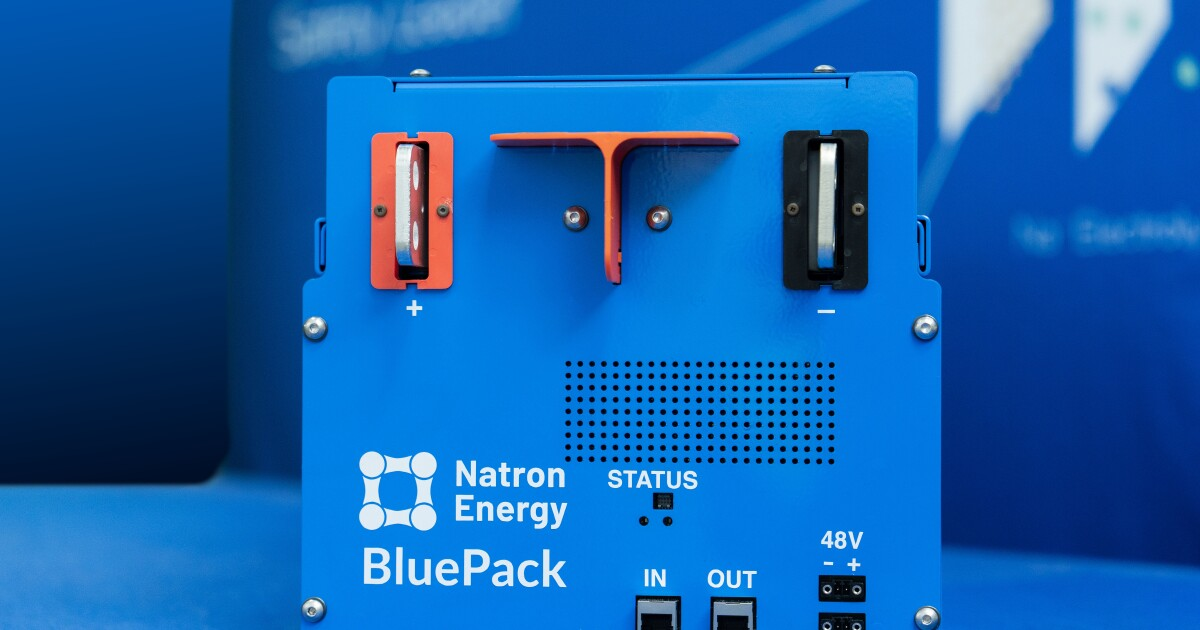50,000 cycles
Wow, a lifetime of 137 years at one cycle per day. This could make off-grid systems mainstream.
Long-time offgridder here. Would love to have a reasonable alternative to lead-acid or lithium. Opted for lead-acid again on the last battery swap around 5 years ago. Squeezed about 12 years out of the last set -though they were pretty degraded by that time. This bank is depreciating faster, probably because of increased use.
Lead acid batteries seem to be less and less reliable lately. The warranties are shorter and shorter as well, which is the best supporting evidence I have beyond needing batteries more often for the 4-5 vehicles I maintain.
For real. It will take up a lot more space than lithium, but if it lasts way longer and should end up being cheaper, it would definitely be the winning choice. Solar array on the roof and a huge outdoor battery in a shed against the house and no more electric bill, ever.
Build your walls out of batteries and tile your roof with solar panels
Make firefighter’s jobs a lot easier. Hell you don’t even need a firetruck to tell the people outside “Yeah, it’s fucked, nobody’s coming out of there”
Sounds like a fire hazard.
deleted by creator
Heck you can have big windows too!
Batteries degrade with age too. It would probably have to be cycled 10 times a day to get that many cycles.
I could see that happening if these are used in gas hybrid cars, or ev taxis, or maybe grid scale energy buffering
They may work for non plug in hybrids, which have quite small batteries that cycle a lot, but the energy density is far too low for full EV vehicles.
Not likely, these are big and heavy and will likely be industrial.
… Sodium Ion are already being sold in EVs.
I had thought this maker had lower energy to weight density than the JAC, but I stand corrected.
The shitty thing right now is grid connection is required by pretty much any building code, and the utilities are getting wise to solar. They’re moving a lot of the fees from power use to connection and line maintenance. My family was looking at solar, but since 2/3 of their power bill is just to be connected to the grid it wouldn’t save enough to make economic sense.
Lower power density, higher cycle life, safer. Sounds good for stationary power storage.
And commuter cars probably. I’d love something I can drive to work and back, and then later upcycle into home energy storage.
CATL showed a 160 Wh/kg sodium-ion battery in 2021 and has plans to increase that density over 200 Wh/kg to better meet the needs of electric vehicles.
Hopefully that happens in a reasonable timeframe. I don’t need high range, I just need cheap to repair or long life for a commuter. Maybe we’ll get something similar for buses and light rail first before getting it for regular cars.
Yes, absolutely. For a regular daily commute to a job that allows you to afford 2 vehicles, having one of the two with a shorter range with more charge cycles makes a lot of sense.
Yup. I’m married with kids, so we need two cars regardless. The commuter just needs to reliably go ~50 miles between charges even during the winter, while the family car needs to fit my wife and kids and go at least 400 miles between charges (we like road trips).
Unfortunately, I haven’t found the right fit since EVs are either too expensive, don’t have enough winter range (e.g. old Leafs), or have too many safety advisories (e.g. batteries catching fire don’t mesh with garage storage). Likewise for family cars. Most current EVs are in the awkward middle: too much range for a commute, and not enough for a road trip.
But if there was an economy car with ~150 miles range and inexpensive batteries, I’d probably buy it.
Yeah, a car that started out with 150 miles of range, has degraded to about 80 miles of range, and is known to be safe would be ideal.
Yup, especially since my workplace has been talking about installing chargers. I don’t know when that’ll happen, but I’m willing to gamble if I won’t need them for a couple years (I might move to another company by then anyway).
batteries catching fire don’t mesh with garage storage
Your gas powered car is more likely to burst into flames than your electric car.
The problems with EV fires are:
- they can easily reignite, and traditional firefighting methods don’t work
- they can happen with a simple puncture, or during charging
- there’s pretty much no warning sign
Whereas with ICE vehicles:
- generally caused by poor maintenance
- overheating (major cause) has warning sensors and can generally be avoided
- are fairly easy for fire departments to deal with
I was considering getting a Chevy Bolt, but the company’s response to charging issues (i.e. don’t charge in your garage) killed my enthusiasm for it. Pretty much everything else either costs too much or doesn’t have enough range. I’d really rather not spend much more than $20k on a car, but the used market has been bonkers.
I think we still need more time/data to get the whole picture. EVs are still in their early stages.
It would be interesting to look at fire rates for vehicles at rest. These types of fires have the potential to become quite serious, as they are often not immediately noticed, especially if the vehicle is parked in a garage or remote area. This additional time allows the fire to spread and intensify.
Since EV fires are typically more intense than ICE vehicles, we should expect EV fires to cause more damage to the surroundings and to spread faster. Though, this danger could be offset if EVs have a lower probability of self ignition.
We should also look at fires while refueling/charging. Lithium cells are most dangerous when charging and discharging. While an overfilled gas tank is easy to spot and may catch fire, a continually overcharged battery is invisible and will catch fire. Also, because of the long charge time of batteries, many EV owners leave the vehicle unattended while charging and would not immediately notice a fire if one were to occur. In addition, EVs are often charged at home, in close proximity to residences and other vehicles, and often within garages. These residential locations do not have the same fire safety requirements and suppression systems as gas stations, so a vehicle fire at home is already much more dangerous and has the potential to severely damage your home.
We have had a century to figure out ICE, but it’s still very early days for EVs, so only time will tell.
deleted by creator
The Volt was really good for this - 50 miles electric and 430 miles gas on a 7 gallon tank.
Unfortunately, PHEVs fell out of fashion in 2018 and are only just coming back into style. I think the Prius is the only comparable car on the market that manages this. The Kia Niro is also looking reasonably good with a 34 mile EV range.
But if there was an economy car with ~150 miles range and inexpensive batteries, I’d probably buy it.
Both are in the $30-$40k range new. You can find a 2017 Chevy Volt for $16k (and I seriously can’t recommend it enough).
I have a non-plugin Prius, and it works really well as a commuter. I got it for $10k like 10 years ago, and it has needed very little maintenance and still gets 45-ish MPG (highway speeds here are 70mph, and I usually go a few mph over).
Ideally, I’d go pure electric for the next one so I’d never need to go to the gas station again. A PHEV means I still need to use some gas since I highly doubt I’d get 50 miles range on our high speed highways, especially if the car is older.
But yeah, seeing the prices going down is good news. The EV discount for used EVs is doing a lot of work.
Ev discount for used ev’s?
US tax credit.
Amazing how far we’re progressing in battery technology in such a short amount of time.
And all it took was $100/BBL gas to get people off their asses. A shame we weren’t pioneering this kind of research 40 years ago.
Probably would have if we didn’t pull out all the stops to subsidize it all to hell and back. 40 years ago was a great time for increasing fuel efficiency and smaller, lighter cars specifically because of gas shortages, and when that got a temporary reprieve we just acted like it could never happen again
I remember NiCad batteries still being used in power wheels toys as a kid. For all I know they may still be, but the battery advancements have been particularly amazing.
Short time? We’ve been kind of stuck for decades on the same tech and working to try and find something else.
Sodium batteries are in development for over 30 years. We were pioneering this kind of research almost 40 years ago and that’s how much time, effort and financial investment this stuff takes. It will be 10 more years to get them everywhere. Technology is not as fast as you think.
Sodium batteries are in development for over 30 years.
Closer to a century. But the investment in the last decade has risen with the price of fossil fuel as well as the sharp fall in short-term available renewable electricity. International investment - particularly in states like China, India, and Germany - have spiked considerably during this time as well. That’s why we’re seeing so many productive discoveries outside the US.
It will be 10 more years to get them everywhere.
HiNA Battery Technology Company began producing EV-ready sodium batteries last year.
TÜV Rheinland approved Pylontech to begin mass producing bulk energy storage systems in March of 2023.
Rollout is occurring at the speed of domestic investment. And while US companies continue to drag their heels, countries with higher electricity demand and fewer fossil fuel subsidies are not waiting around.
I need long range and I need it at -30F. A round trip to the grocery store or to see a doctor is 100 miles and can be as much as 300 miles. I can’t justify an EV until I can get that kind of range at an affordable price. $40,000US+ ain’t really affordable for most people.
I almost bought a Chevy Bolt, but between not being able to actually find one to see and touch, and the almost good enough range, I just didn’t feel comfortable with such a large purchase.
Are you in Alaska or middle of nowhere main?
I think your use case is pretty niche, but 100 miles in winter (even if ridiculously cold) isn’t that unreasonable. For me, that means a round trip to the airport, and that can absolutely happen in winter (e.g. family visiting for Christmas or something).
And yeah, I’m not paying $40k for a car, especially at these loan rates. I spend a bit more than $1k on gas, so if an ICE is $25k and electricity is completely free (it’s not), it would take 10 years to be more economical. It’s even worse that EV batteries and most parts of the electrical system just aren’t repairable by your average mechanic, and battery replacements costs like $10-20k, which is about what I’m looking to pay for an entire car anyway.
I’m definitely interested, and I’ll buy if the price is right. Chevy Bolt and Nissan Leaf are about right, but they’ve had battery issues in the past, but I’m seriously considering them, just looking for the right deal.
I’m in northern Minnesota. There is a fairly large low population area across the north central and northwestern part of that state. Not many people live here. And yes, the use case is pretty niche compared to anyone living in a more urban area. But while there aren’t many of us up here, we do exist.
Financial constraints are the biggest issue with the adoption of EVs for most people. It is still cheaper for many to own an ICE than invest in an EV. The pay back is painfully slow. Still, if it hadn’t been for the battery problems of the Bolt, I probably would have bought one. It would have been just doable for my needs as a second vehicle.
I have looked into hybrids also. The problem there is since I live in a very rural area, the long distances I travel means I drive at highway speeds for almost all of the trip. The ICE motor would run the whole trip anyway. Paying for a battery that is seldom used and dragging the extra weight around makes no sense.And it would be difficult to something repaired if it needed it.
For hybrids, I drive a Prius and mostly on the highway (70mph speed limit here) and I generally get 40-45mpg. I haven’t had anything to wrong with the hybrid side, and it’s not a plug-in hybrid. Prices are kinda high for them right now, but I got mine for $10k used about 10 years/90k miles ago (had 60k miles when I got it).
That said, I’m in Utah where winter temps rarely go below 10F, so I have no insight into really could winters.
But yeah, EVs really need to come down in price to make sense for me.
That’s great for you, I’m kind of jealous. The Prius is a very good vehicle, either as hybrid or ICE.
Howdy Neighbor, you could always move a little further north. We’ve got lots of people driving EVs up here in Winnipeg! I’m kidding, but there is at least some charging infrastructure coming rurally here in Manitoba, and you are starting to see a lot of commuters using them for 100+ km (one-way) commutes. That being said, we have similar issues if you need to drive long distances between rural centers, but the government subsidies to help install L2 chargers seem to be making a difference as more and more municipalities are installing at least one charger somewhere. I can understand how people are still hesitant about winter, with -20C (-5f) to -30C(-30f) being not uncommon (for now…).
Hi! Neighbor! I am a lot closer to Winnipeg than the Twin Cities.
There are government programs to install chargers here also. The problem is, there is no money to fix those chargers when they stop working. My Daughter, who is a research engineer in the fields of public charging for EVs and HVAC systems, will tell you that she can get all kinds of money to install them, but there is no money to actually keep them working. And it’s expensive to repair them. So it’s nearly useless at this point in time to install them only to have them break and not get repaired. She is currently doing a 10 year study of a string of 60 chargers across the northern part of the state from Red Lake to Brainard to the Twin Cities.
Awesome! Isn’t that always the way. People, agencies and governments love to put their name on new and shiny projects, but never want to fund labor or upkeep. I work for a non-profit and a big part of my job is begging for money to help us maintain the amazing infrastructure we have, but get very little support to upkeep.
I’ve spent a lot of time visiting Roseau and Warroad in my life, so it’s always nice to meet an American neighbor in the wilds of the internet. Manitoba is actually a cool place to visit, and your dollar goes a lot further. Come up to Winnipeg for a weekend and you’d be surprised how much more there is to do now than even a decade a go. It’s food and music scene is awesome.
Where do you live that it’s often -30? And if you need to drive 300mi to a doctor’s for a medical emergency at that one time if year, do you have someone else you could ask or only drive there and worrying about charging later?
Northern Minnesota often sees those temperatures. And if it’s a real medical emergency, you could well be dead by the time anyone can get to you - IF you have cell service to make a call. If they do make it to you, you will probably be airlifted by helicopter. Making a a 100+ mile trip, would be just for a clinic visit or even to pick up a prescription, which I did last Saturday for my Wife.
100+ miles is fine for most any EV. My bolt during the winter was still able to get 200mi+ at 70mph in sub zero F weather. With a home charger it’s fine. It’s road trips that would push further. I’ve found charging adds maybe 25% time to long trips. But that doesn’t seem to be the use case you’re referring to.
…that’s why the article says it.
Listen, if he came to that conclusion in a vacuum without reading the article, that’s kind of neat on its own.
Namaste.
Higher cycle life might also make it good for hybrids, since they cycle their batteries a fair bit.
For sure. They would likely use a lower capacity battery due to these being much less energy dense, though. Hybrids have been using bigger batteries and only using around a 30% zone of charge state in order to greatly prolong battery degradation. I’d imagine auto makers would try to keep the batteries around the same size, but start using more like a 60 or 70% zone, though. So they’ll take advantage of that higher cycle life.
You won’t get an automaker to care about making a battery that lasts much beyond 10 years.
non-flammable end use
Safe and stable chemistry
Oh neat, finally a non-explody and/or unstable battery lmao
Well, only relatively.
In order to work batteries need to have a certain amount of instability built in, on a chemical level. Them electrons have to want to jump from one material to a more reactive one; there is literally no other way. There is no such thing as a truly “safe and stable” battery chemistry. Such a battery would be inert, and not able to hold a charge. Even carbon-zinc batteries are technically flammable. I think these guys are stretching the truth a little for the layman, or possibly for the investor.
Lithium in current lithium-whatever cells is very reactive. Sodium on its own is extremely reactive, even moreso than lithium. Based on the minimal lookup I just did, this company appears to be using an aqueous electrolyte which makes sodium-ion cells a little safer (albeit at the cost of lower energy density, actually) but the notion that a lithium chemistry battery will burn but a sodium chemistry one “won’t” is flat out wrong. Further, shorting a battery pack of either chemistry is not likely to result in a good day.
I believe it is still better due to raw material availability?
It is definitely that. That’s kind of the point, actually. Sodium is easier to come by than lithium and does not require mining it from unstable parts of the world, nor relying on China.
nor relying on China
The appeal of China is largely in the size of the labor force. Whether this tech is more or less feasible than cobalt and lithium, businesses will still want to exploit the large volume of cheap Chinese labor in order to build them.
I’m sure they’ll want to, but that’ll be a little better than need to, i.e. relying on them for the raw materials as well.
If you consider Australia unstable, sure, maybe for humans, the animals are fine unless you’re Steve Irwin, just dont go diving with stingrays
You who are so wise in the ways of science, can you explain to me if this is safe/will be super dangerous if exposed to water? Doesn’t sodium, like, blow the fuck up when it comes in contact with water?
Yeah throwing a piece of sodium metal into water will cause a violent reaction. Even touching it with your finger is bad because of the moisture on your skin.
But sodium chloride (table salt) dissolves in water easily and safely, resulting in an aqueous solution including sodium ions.
Well, metallic sodium liberates hydrogen real fast on contact with water, which I guess is tantamount to the same thing.
Yes. But not to the same level as just dropping a brick of pure sodium in a bathtub. In a battery like this there is not pure lithium/sodium/whatever just sloshing around inside. The sodium is tied up being chemically bonded with whatever the anode and cathode materials are. Only a minority of the available sodium is actually free in the form of ions carrying the charge from cathode to anode.
Just as with lithium-ion chemistry batteries, it is vital that the cells remain sealed from the outside because the materials inside will indeed react with air, water, and the water in the air. Exposing the innards will cause a rapid exothermic reaction, i.e. it will get very hot and optionally go off bang.
Okay, that makes a lot of sense. I was asking because I wondered how viable this would be in boats/ships, outdoor areas, off grid cabins, et cetera. Seems like it’s basically the same thing, then, right? Like, proper battery maintenance and you’re good?
There is no such thing as a truly “safe and stable” battery chemistry.
Is it even possible to have energy storage of any kind that is truly safe and stable? Some are better than others, of course.
Giant springs are fucking scary. Energy is dangerous when you store a lot in one place.
Large flywheels are well known to be terrifying mechanical monsters, despite just being a spinning disc
A couple decades ago I worked at a place that did power generation turbine controls.
One thing I worked on was a redundant sync check for connecting turbines to the grid. A turbine has to be brought up to speed, about 3600rpm in the US, before being connected to the grid. The sine wave coming out of the generator needs to match the sine wave on the grid.
If they are mismatched when the huge breaker closes, it’s not a shock or fire hazard, it’s an explosion hazard.
Dams are scary too, I just hope people are able to decommission them slowly when the time comes. Otherwise the deluge is going to suck.
Is it even possible to have energy storage of any kind that is truly safe and stable? Some are better than others, of course.
considers
Kinetic energy of a body in orbit, I suppose. Like, you want to accelerate the Moon, you get a bigger orbit. We pull energy out of it via tidal generators, and in theory, we could speed its orbit up, increase its altitude.
I mean, it could theoretically smack into something, but it’s not gonna hit the Earth very readily, and the speed of an object that isn’t in Earth orbit, like an asteroid or something that hasn’t been captured by Earth’s gravitational field, is probably more of a factor in a collision than the speed of something that is.
At a smaller scale, I expect that thermal energy storage can be pretty safe, as long as you keep it within bounds. Like, if you wanted to insulate a lake and crank its temperature up or down ten degrees, probably not a lot that it could do even if the insulation was penetrated. The rate of energy release is gonna be bounded by convection.
The orbital one sounds interesting. That’s a lot of energy, and it could do a lot of damage, but it seems very stable if left untouched.
My gut suspicion is that with something more safe/stable, you would also be dealing with a low quality/potency source and/or low efficiency.
On a small scale yeah. The sun heats rocks and they’re able to store heat for up to an hour or so. Cats can attest to that.
Same with large bodies of water; the ocean, lakes, pools, etc.
I guess in my head I was implying that it was energy humans store for other humans to use at grid scale. When I said "of any kind” I guess that’s not what I meant, lol.
So in my line of thinking, you’re right about e.g. using the sun to heat a rock. But if we use the sun to heat something for electricity generation, or we heat some medium for energy storage, I bet that will be pretty potent.
Besides, past the small scale into the smallEST scale, it’s all just energy anyway, man. 😎
If you poke a hole in it, is it just as exciting as lithium?
A different kind of excitement without flames.
Sodium cells have been out of the lab for at least 8 months now.
They’re still a bit pricey but the price is quickly falling
These are more fun then lipos… I wounder if u pack a tesla full of these…will it manage to achive escape velocity after a crash? I mean gas cars and lithium batteries right now just turn car into lots fo smoke and flames…but these might really change how we see crashes…
Edit: I feel like I need to add an /s somewhere…the amout of serious replies to this comment are concerning 🤦
That explosion doesent seem much bigger than a firework thats smaller than the battery’s size. With as much as a car weighs and the amount we already do to protect batteries in electric cars i imagine the explosion from these could be easier to manage safely than a lithium fire. I also wonder how harmful the fumes are compared to lithium
Especially considering there’s no fire from a sodium cell, just a quick bang. They definitely seem a lot safer.
We already know how to take care of this in big capacitors. You put a breakaway vent in.
Yep, less/no fire is very important when creating battery banks with many cells. The probability of single cell failure spreading to adjacent cells is reduced, making a catastrophic failure of the entire bank less likely.
My hopes of flying cars has been dashed 😐
LiPo batteries of the same capacity actually have the potential to be much more dangerous than the sodium cell shown here.
LiPo packs typically use flat, soft walled cells which are far more susceptible to being punctured. In the event of a puncture or overcharge event, high temperature enduring flames are produced, with the severity and duration largely depending on the amount of energy within the cell. LiPo batteries also degrade at a much faster rate (both over time and with charge cycles) and have been known to spontaneously combust in storage while at rest.
With the sodium battery, the thrust produced by the puncture could have been easily been overcome by properly securing the cell.
Here is an alternative Piped link(s):
A different kind of excitement without flames
Piped is a privacy-respecting open-source alternative frontend to YouTube.
I’m open-source; check me out at GitHub.
It is if it’s a dry electrolyte cell.
the notion that a lithium chemistry battery will burn but a sodium chemistry one “won’t” is flat out wrong
Flinging a brick of sodium into my bathtub to prove you wrong.
Post vid, please.
Doesn’t take into account the reactivity difference with the matrix either. Solid state batteries are in a vitrified matrix essentially, and glass don’t burn. Would make a lithium solid state battery likely safer than this.
But I like my inextinguishable fires :(
Lead acid has been there for a hundred years, lithium phosphate is another option.
Nickle-iron
The mere fact that we can stop scorching the earth for lithium and cobalt is enough.
Now, we’ll scorch it for salt.
Well, we have nearly an endless supply of salt here on the Internet, should be an easy transition.
Desalination of water is basically an endless supply of salt, we can’t just push it back into the ocean because that increases the salt concentration in the ocean which is actually not great and when done at scale. But we didn’t really have anywhere else to put the salt because there’s already an abundance of it for use elsewhere but if we start using salt for Batteries it would be a great place for salt from desalination to go
can’t just push it back into the ocean because that increases the salt concentration in the ocean which is actually not great and when done at scale
Only locally, it’s absolutely not a problem globally. That water will go back into the ocean soon enough. We’re not generally putting wastewater in aquifers. The same is true of lithium. Both sodium and lithium form salts that dissolve in water, so over time their biggest concentration is in the water and that’s why we refine it from salt flats.
I don’t consider the refining of lithium to be a huge problem, other than the fact that it usually just means they’re trucking a bunch of water to the desert for concentration and evaporation ponds (or worse, using the local groundwater in the desert instead of trucking in desalinated water like they should be).
To put it into perspective, high lithium brine and ore reserves contain about 14 million tons of lithium. Seawater contains over 2 trillion tons. We currently have a yearly consumption somewhere under 200 thousand tons. We won’t be hitting a lithium resource crunch anytime soon, it’ll just get more expensive. If we ever get hydrogen fusion running, we’d have to separate a bunch of lithium-6 which makes up under 5 percent of lithium.
Only locally
You make that sound like it isn’t an issue. Massive ocean die-offs in a localized area is still a very bad thing.
There’s a reason why oil spills are treated with such seriousness. Globally, an oil spill is also not a problem.
It depends on how local we’re talking about. If you build a pipe out of the littoral zone into the ocean with multiple outputs you likely wouldn’t kill much of anything but a few plankton. The intake pipe is often worse than the output pipe for wildlife.
For a place like, say, the the Persian Gulf, that uses oil for heat desal and gets their intake and output from a sea so it’s all littoral and doesn’t as quickly exchange it’s water with the ocean, of course it’s an environmental nightmare. It’s naturally saltier without desal because of the higher evaporation rate and small comparative inlet size of the straight of hormuz, but at this point its 25% saltier than the rest of the ocean thanks to that desal.
Are you trying to spell literal? Not trying to be a dick, just unsure if you have a different word in mind.
Desalination is also a good way of getting lithium right now, it’s just a bit less cost effective than surface mining dried oceans currently. Maybe if sodium demand also goes up, it’ll be effective to capture desalination salts for both lithium and sodium.
that increases the salt concentration in the ocean which is actually not great and when done at scale.
I dealt with CaSO4 (calcium-sulfur salt) dumping before. It is considered fine (by DNV) as long as it not in brackish waters or too close to the shore or in most of the North Sea. It’s just adding salt to salt water, salt is supposed to go there.
I guess if you were doing it at insane scales it would be best to run a pipeline out, run your seapumps harder, or have ships do the dumping. Not sure.
As usual there is absolutely no mention whatsoever anywhere in any of the articles I can find or from the company themselves about what the fucking price is
Why would there be? I didn’t think these were for consumers.
Since they say they’re putting them out from 48V to 800V, 48V is what most inverter systems use, so I imagine they’re targetting that size for “consumers” at the single-house PV system size. If the cycle counts and low temperature charging characteristics come true, they will be popular.
American manufacturers like this like to shoot themselves in the foot by pricing their new and innovative battery technology at the datacenter customer size, find out they have no market, use up all their capital, then sell the tech to a big Chinese company like BYD or CATL. So once they’ve complete this lifecycle, I’d expect a couple more years before they’re readily available to actual consumers. Probably expect to see them then at about LFP prices, like $90/kWh wholesale price.
https://diysolarforum.com/threads/upcoming-sodium-ion-batteries.61679/
they say they’re putting them out from 48V to 800V, 48V is what most inverter systems use, so I imagine they’re targetting that size for “consumers” at the single-house PV system size.
48 volts is also what telecom uses in their infrastructure. That’s a much bigger market (and one with deeper pockets) than consumer installs.
Then why bother putting the article here? Who out of us is going to actually care. I’m looking to expand the storage on my off-grid property and I would absolutely love something other than lithium especially if it can get cheaper per kilowatt hour. I got five acres to work with so I really don’t care about the density just needs a decent cycle life and price
Thats great that you are looking for alternatives, but you aren’t the only reader here.
Other people have other interests and are looking for different things than you are.
It’s a great development that we should keep our eyes on, as some years into the future it will most certainly be available for regular consumers, including you with your install.
Then why bother putting the article here?
Because it’s interesting regardless of whether I can buy it or not?
I watch reviews on computer hardware that I definitely can’t afford, because it’s interesting.
These aren’t for you to buy directly, they are for manufacturers to negotiate a price and order in bulk from the company to then integrate them into their products or production facilities.
Late last year they were talking about $40 for a KWH which compared very favourably to LifePO4 that was more like $130 at the time and Li-ion that was more like $200. However right now on alibaba you can get a 200Ah battery for about $60 and the LifePO4 300Ah are now down in the $50 range which is an incredible drop in the space of 6 months. So in practice they are less dense and more expensive but I think its new technology introduction pricing and at some point it should be about a third cheaper than LifePO4 for the same capacity, all be it a bit bigger and heavier and quite considerably cheaper than Li-ion for the same capacity.
The small 18650 and other small sized cells have started appearing on aliexpress as well so its possible to get those too butt they are a lot more expensive than a basic Li-ion 18650 at the moment for a lot less capacity. I think its mostly the bigger cells that most people interested in Sodium Ion will be wanting (home battery and grid storage solutions and some of the low/mid range cars) more than small cells since typically the smaller stuff you want to maximise capacity even if it costs a bit more and most will want li-ion and ideally the newer nearly solid state li-ion that doubles capacity per KG.
You also have to remember these are specifically designed to favor charge cycles over capacity… Only for stationary
Some EV manufacturers, especially in China, have already shown interest in the technology, for all I know.
The ones from this company are less energy dense
Sodium batteries are already in electric cars many months ago
Also you could buy individual cells on AliExpress
I don’t think the article was trying to imply that they weren’t already in use in electric cars, just that they would be better for them.
https://www.amazon.ca/dp/B0CCVPZL78 these have been in my shopping cart for a few months.
Sodium? Like, salt sodium?
Salt is sodium chloride. Sodium is a metal, and it is right below Lithium on the periodic table (behaves and reacts similarly).
No, Sodium like the PlayStation game Sodium.
Yes, that very sodium. The one that combines with chlorine to give you table salt.
Super abundant, incredibly cheap, much more environmentally friendly.
Good video going over practical pros and cons currently:
That is some great news
I couldn’t find much in the chemistry but this seems exciting.
Chemist here. There’s a lot in the chemistry and it is exciting
Nuclear bros hate this one simple trick.
I love nuclear but this new battery tech has me super excited
It increases the viability of renewable energy sources (especially solar) which makes me hella happy
I love nuclear
I’m not trying to be a dick but could you explain why?
Not who you asked but look at France’s energy mix compared to the US.
Imagine where the US could be today regarding emissions if we had kept up with nuclear this whole time.
I totally get that but that ship has sailed with renewables being way cheaper now.
Perhaps a bad example because most people undermine them, but China has still decided to move forward with 4 different nuclear facilities this year despite having an ABUNDANCE of solar manufacturing. If they found that decision worthwhile I would think the opposite, assuming most of the reasoning is current battery tech can’t sustain dark periods at a massive scale, but I’m not an expert.
Also just saw you mentioned nuclear costs in another comment, I suggest you look at South Korea and China’s cost per facility compared to the US, they’re able to build and maintain facilities at about half the US does.
Literally every source I’ve come across has nuclear being massively more expensive than renewables + storage, at least in the West.
The market decides what to invest in in a capitalist economy and they will tend to go for the thing that makes them the most money in the shortest time possible and that’s why new nuclear isn’t happening much.
If you’re advocating for public ownership of utilities so there’s central planning and long term thinking instead of profit chasing, that’s an interesting debate to have.
@IchNichtenLichten
Not OP, but why not love it? It’s one of the cleanest, greenest, safest, and efficient power sources we have.
@GormadtThis is exactly why I love nuclear
And who can forget the classic, “Where is the waste from fossil fuels? Take a deep breath, it’s in your lungs. Where is the waste from nuclear power? Where we store it.”
Yes there have been disasters but the waste from those are tracked, in a specific location, and can be cleaned up. The default state of fossil fuels hits every living breathing thing on Earth.
And even factoring in the impact from disasters nuclear is still the safest. And we have even safer designs for reactors nowadays then the reactors that had those disasters.
Nuclear suffers from the airplane fallacy where when something goes wrong it tends to go really wrong and a lot of people die at once and it makes the news. But fact is, many orders of magnitude more people have died from fossil fuel plants, mining, byproducts, and combustion. They just die slower, in smaller groups, so it doesn’t get reported on as easily.
They just die slower, in smaller groups
looks doubtful
I mean, I agree with your broader point that it gets a disproportionate amount of coverage and scares people, but I dunno about nuclear accidents killing people quickly and at once.
I mean, Chernobyl was the worst nuclear incident, ya? Like, there were definitely some people who were killed right there, but it was a pretty small group, even so.
https://en.wikipedia.org/wiki/Deaths_due_to_the_Chernobyl_disaster
There is consensus that a total of approximately 30 people died from immediate blast trauma and acute radiation syndrome (ARS) in the seconds to months after the disaster, respectively, with 60 in total in the decades since, inclusive of later radiation induced cancer.[2][3][4] However, there is considerable debate concerning the accurate number of projected deaths that have yet to occur due to the disaster’s long-term health effects; long-term death estimates range from up to 4,000 (per the 2005 and 2006 conclusions of a joint consortium of the United Nations) for the most exposed people of Ukraine, Belarus, and Russia, to 16,000 cases in total for all those exposed on the entire continent of Europe, with figures as high as 60,000 when including the relatively minor effects around the globe.
So, immediate deaths were about 30. I mean, that airline crash we had out in those Spanish islands, whatsit called…
googles
Yeah.
https://en.wikipedia.org/wiki/Tenerife_airport_disaster
The Tenerife airport disaster occurred on 27 March 1977, when two Boeing 747 passenger jets collided on the runway at Los Rodeos Airport[1] (now Tenerife North Airport) on the Spanish island of Tenerife.[2][3] The collision occurred when KLM Flight 4805 initiated its takeoff run during dense fog while Pan Am Flight 1736 was still on the runway. The impact and resulting fire killed all on board KLM Flight 4805 and most of the occupants of Pan Am Flight 1736, with only 61 survivors in the front section of the aircraft. With a total of 583 fatalities, the disaster is the deadliest accident in aviation history.[2][3]
I mean, that killed about 20 times the immediate number of deaths in Chernobyl. I guarantee you that that collision didn’t get twenty times the media coverage or concern of Chernobyl.
Even if we use the highest estimated total death figure listed above for Chernobyl for the “increased death rate from minor effects around the world” – 60,000 – and I suspect that that’s being awfully pessimistic – it kind of gets dwarfed by how many similar deaths around the world we casually ignore from coal power and the like due to particulate emissions.
googles
If one’s worried about death rates, nuclear’s at about the bottom of the list.
https://ourworldindata.org/grapher/death-rates-from-energy-production-per-twh
Isn’t it even safer than wind energy ?
And now we’re in an age of nuclear fusion. My kid or grandkids may live in a world powered by even cleaner reactors. Which is great because they will probably have to live entirely indoors.
Eh, I feel like we’ve been in an age of nuclear fusion for decades, it’s always just around the corner…
But maybe this latest set of breakthroughs will be it. I’ll believe it when I see a production scale plant.
It has value in terms of research but I’ve seen no evidence that we’re even remotely close to hooking a fusion reactor up to a grid.
Sure, I get that. My priorities are clean energy that is as cheap as possible and nuclear just can’t compete on cost.
@IchNichtenLichten
It might have a higher initial upfront cost, but the return on investment over a plant’s whole lifetime makes it one of the cheapest. And even then, they don’t take long to break even.This isn’t true but I’m happy to be proved wrong.
@IchNichtenLichten
I’ve found this reference that seems good:https://www.world-nuclear.org/information-library/economic-aspects/economics-of-nuclear-power
There’s certainly more, but I’m not nuclear powered and don’t have the mental energy for online debate 😁
How about we regulate all the other power sources as heavily as we regulate nuclear?
This is an extremely unfair comparison, because nuclear has to do things (Even leaving aside the Nuclear part of it) that no other energy source does.
You know any coal supply chains that have to track each atom that they ever dig up?
And even leaving aside cost, what about other benefits?
How about we regulate all the other power sources as heavily as we regulate nuclear?
I can’t believe I even have to mention this but you realize that nuclear power has safety issues that wind and solar do not? Hence the regulation.
And even leaving aside cost, what about other benefits?
Such as?
Won’t nuclear techy bros use the nuclear energy bits and put them into the sodium thingies to keep them juiced up?
Yeah, I’m not sure why this would be an argument against nuclear power. Does the person above think these batteries are self-charging?
Probably it’s one of those people who didn’t do much in school aside from looking cool
I didn’t see anything about round trip efficiency. I’ve heard that’s a big downside so it might make energy storage a hard sell.
97% RTe from what I’ve heard.
That would be awesome, any idea where you heard that, I’ve read other sodium based technologies have ~65%
https://www.faraday.ac.uk/wp-content/uploads/2021/06/Faraday_Insights_11_FINAL.pdf (bottom of last column on page 3)
This article is saying 93% but I thought I’d seen 97 somewhere. Might have been marketing bullshit. Though this paper is 3 years old now, so there’s been time for improvement. What hits the market right now may not be up to that number either, so I wouldn’t disbelieve 65% either.
Finally, some good fuckin’ news. Curious to see if Fairphone will be the first to attempt adopting this.
Only thing I’ve seen that has worried me about them is how they seem to have turned a fire hazard into an explosive hazard in terms of battery safety.
explosive hazard
Can you elaborate on that? I was just reading the data sheet for these batteries, and these are tested with a ballistic penetration test, resulting in no fire.
I’m presuming this concern is from watching videos of elemental sodium reacting with water, which stands to reason, but I’ve not heard of exploding batteries
Just my impression on seeing videos of these tests on videos, which seem to result in the battery exploding violently and essentially escaping any attempt at confinement instead of catching fire. https://www.youtube.com/watch?v=W1ya_ls1zkA
That’s way less extreme than I would’ve expected.
What were you expecting? It’s literally an explosion. Add a few thousand of them in row in EV battery style if you want a bigger explosion.
Here is an alternative Piped link(s):
https://www.piped.video/watch?v=W1ya_ls1zkA
Piped is a privacy-respecting open-source alternative frontend to YouTube.
I’m open-source; check me out at GitHub.
Interesting. I wonder how that compares to a similar Li-ion cell. Also it’s a shame there wasn’t a close-up on the markings of the battery in that video to know what it is exactly. I don’t imagine all cells are equal.
The battery packs from the article, for instance, are not constructed from cylindrical cells, but from large thin and flat square cells. The cathode material appears to be unique as well, as far as I can tell; who knows what’s in those blue cylindrical cells.
You can look at other videos in his channel that answer your doubts. 18650 battery cells are usually connected together into battery packs and BMS, and the industrial process is pretty standardized. Just like Li-ion you can have different cell structures, but the inside remains the same.
No fire could have occured during the penetration test because the resulting explosion removed all oxygen from the surrounding environment. -s
Sodium Ion batteries are nonflammable. They are safer than most of what we already use.
Guessing reading comprehension is not your forté.
I’ve probably read more books than you’ve ever smelled. So why don’t you take a big whiff of farts and think on that?
And a shining personality to boot …
What, did you expect a nice response after you replied with an attempt to insult my ability to read? You get what you pay for, dude.
Actually, you replied with just what I expected. I would have been surprised if you simply had tried to reread instead of responding as you did. Enjoy the block, buddy.
Removed by mod


























